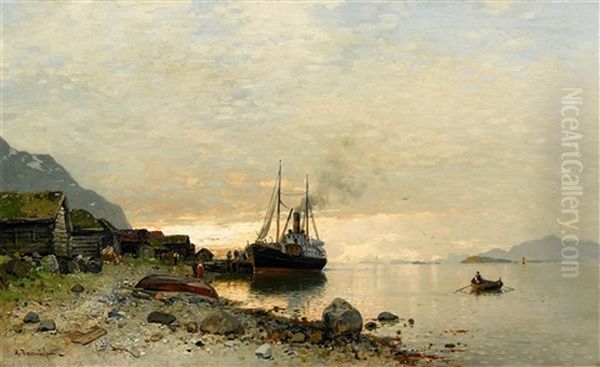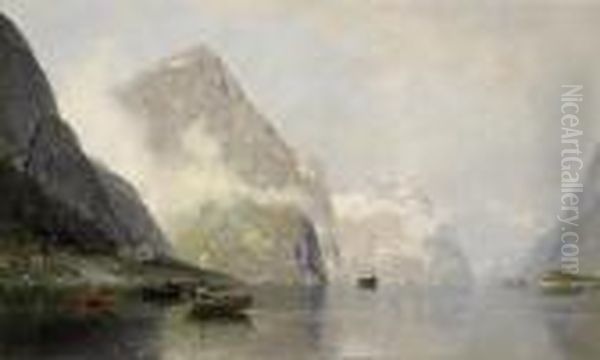Georg Anton Rasmussen stands as a significant figure in 19th-century landscape painting, a Norwegian artist who found fame and a second home in Germany. His life and career bridged the artistic traditions of Scandinavia and the influential Düsseldorf School, culminating in a body of work celebrated for its dramatic and atmospheric depictions of Norway's unique natural beauty, particularly its iconic fjords. His journey reflects the path of many Nordic artists of his time who sought training and opportunities abroad, contributing to a vibrant exchange of artistic ideas across Europe.
Early Life and Artistic Awakening
Georg Anton Rasmussen was born in the coastal city of Stavanger, Norway, in 1842. Growing up surrounded by the dramatic landscapes that would later define his artistic career likely instilled in him a deep appreciation for the natural world. His initial artistic inclinations led him to seek formal training, a common step for aspiring artists of the era. His early studies took place in Stockholm, Sweden, where he attended the Royal Swedish Academy of Fine Arts (often referred to simply as the Stockholm Academy). During this formative period, he is noted to have studied within the studio environment associated with a figure named Rhode, absorbing the foundational principles of drawing and painting prevalent in Scandinavian art education at the time.
This early training in Stockholm provided Rasmussen with essential skills but, like many ambitious Scandinavian artists, he looked towards continental Europe for more advanced instruction and exposure to broader artistic currents. Germany, particularly the city of Düsseldorf, was a major magnet for landscape painters from across Northern Europe, including Norway. The city's renowned art academy had established itself as a leading center for landscape painting, fostering a style that blended Romantic sensibilities with detailed naturalism.
The Düsseldorf Influence: Achenbach and Gude

In 1863, at the age of 21, Rasmussen made the pivotal move to Düsseldorf to enroll in its prestigious Kunstakademie (Art Academy). This decision placed him at the heart of one of Europe's most dynamic artistic environments for landscape painting. He was fortunate to study under two of the school's most distinguished professors: Oswald Achenbach and Hans Gude. Both were masters of landscape painting, though with distinct approaches that would profoundly shape Rasmussen's development.
Oswald Achenbach (1827-1905), a prominent German painter known for his vibrant and atmospheric depictions, often of Italian scenes, emphasized capturing the effects of light and color. His influence likely encouraged Rasmussen to develop a more painterly technique and a sensitivity to atmospheric conditions. Achenbach, along with his brother Andreas Achenbach (1815-1910), was a leading figure of the Düsseldorf School, known for moving beyond the highly detailed, sometimes rigid style of earlier proponents like Carl Friedrich Lessing (1808-1880) or Johann Wilhelm Schirmer (1807-1863).
Hans Gude (1825-1903), a fellow Norwegian, was perhaps an even more direct influence, particularly regarding subject matter. Gude was a leading figure in Norwegian national romantic landscape painting and had established a strong reputation both in Norway and Germany. His mentorship provided Rasmussen with a direct link back to his homeland's artistic traditions while grounding him firmly in the technical excellence demanded by the Düsseldorf academy. Gude's own majestic fjord and mountain scenes undoubtedly resonated with Rasmussen's inclinations. Studying under Gude placed Rasmussen within a lineage of Norwegian artists who sought to capture the sublime power and specific character of their native landscapes.
Rasmussen's time in Düsseldorf was crucial. He absorbed the school's emphasis on meticulous observation, careful composition, and the dramatic rendering of nature. While some early works reportedly depicted German valleys, reflecting his immediate surroundings and perhaps the influence of Achenbach's broader European focus, his artistic identity soon became inextricably linked with the landscapes of Norway.
Master of the Norwegian Fjord
Following his studies, Rasmussen's artistic focus solidified around the subject that would bring him the most renown: the Norwegian fjords. He developed a style that skillfully combined the detailed realism learned in Düsseldorf with a heightened sense of Romantic drama and an increasingly nuanced handling of light and atmosphere, sometimes described as having impressionistic qualities or a "fresh technique." He excelled at capturing the towering cliffs, reflective waters, and changing weather conditions of these unique geological formations.

His paintings often feature vast, panoramic views, emphasizing the grandeur and scale of the fjords. He masterfully rendered the interplay of light on water and rock, capturing the cool, clear light of the north. While the landscapes themselves were the main subject, Rasmussen frequently included elements of human life – small boats, figures on the shore, or coastal settlements – which added narrative interest and provided a sense of scale, highlighting the relationship between humanity and the imposing natural environment. This inclusion of "staffage" (small figures or animals within a landscape) was a common feature of the Düsseldorf tradition.
His approach resonated with the prevailing tastes of the time, which favored dramatic, emotionally evocative landscapes. The Norwegian fjords, with their inherent drama and sublime beauty, were perfect subjects for this sensibility. Rasmussen's ability to convey both the specific topography and the emotional impact of these scenes contributed significantly to his popularity.
Representative Works and Themes
Several works stand out in Georg Anton Rasmussen's oeuvre, showcasing his skill and thematic interests. Folkeliv ved norskysten (roughly translated as "Folk Life on the Norwegian Coast"), dated around 1870 and notably exhibited at the prestigious Munich International Art Exhibition in 1879, exemplifies his interest in combining majestic scenery with depictions of local life. Its exhibition in Munich underscores his growing international recognition.
Another key work is Sognefjorden med folkeliv en sommerdag ("Sognefjord with Folk Life on a Summer Day"), painted in 1890. This is often cited as one of his most famous paintings, likely capturing the Sognefjord, Norway's longest and deepest fjord, bustling with activity under a summer sky. Such works cemented his reputation as a specialist in fjord painting, capable of rendering these complex scenes with both accuracy and artistic flair.
His painting Fjord i sommer ("Fjord in Summer"), dated 1870, possibly depicting a scene from the Helgeland region, further illustrates his focus on specific locations and times of year. The title itself highlights his interest in capturing the seasonal variations and atmospheric effects, particularly the vibrant light of the Nordic summer. A work titled Norwegian Fjord Landscape with a Ship is also mentioned as characteristic, emphasizing the recurring motif of maritime activity within the grand fjord setting. Beyond the fjords, Rasmussen also explored forest themes, tapping into a broader Romantic fascination with woodland interiors that was prevalent in German and Scandinavian art since the early 1800s.
These works collectively demonstrate Rasmussen's commitment to the Norwegian landscape, his technical proficiency honed in Düsseldorf, and his ability to infuse his scenes with romantic feeling and atmospheric sensitivity. His use of color was noted, contributing to the vividness and appeal of his paintings.
Contemporaries and Artistic Milieu
During his time in Düsseldorf, particularly in the 1870s, Rasmussen became associated with a group of fellow Norwegian painters who specialized in fjord landscapes. He was reportedly considered one of the "three brothers" alongside Adelsteen Normann (1848-1918) and Hans Dahl (1849-1937). Both Normann and Dahl achieved considerable international success painting similar subjects, often characterized by bright light and picturesque scenes, catering to a large tourist and collector market. Their association highlights the strong presence and specific focus of Norwegian artists within the Düsseldorf art scene during this period.
Rasmussen's connection to Hans Gude remained significant, not just as a teacher but as a leading compatriot artist. He also operated within a broader context of Norwegian landscape painting that included figures like Fritz Thaulow (1847-1906), who later moved towards a more distinctly Impressionist style. While Rasmussen's style retained strong roots in Düsseldorf Romanticism, his attention to light effects shows an awareness of newer artistic trends. Comparing his work to the starker realism or symbolism emerging later with artists like Christian Krohg (1852-1925) or the revolutionary expressionism of Edvard Munch (1863-1944) helps place Rasmussen within the specific historical trajectory of late 19th-century Norwegian art.
His earlier training in Stockholm connects him to the Swedish art scene, potentially interacting with contemporaries associated with the Royal Academy there, such as landscape painters Edvard Bergh (1828-1880) or Alfred Wahlberg (1834-1906), although specific interactions beyond his teacher Rhode are not detailed in the provided sources.
Later Career in Berlin and Recognition
After establishing his reputation, Rasmussen eventually moved from Düsseldorf. Sources suggest he worked for a time in Copenhagen and later, around 1899 (though an earlier date of 1865 is also mentioned, perhaps indicating initial visits or connections), he relocated to Berlin. The German capital was rapidly becoming a major political, economic, and cultural hub, attracting artists from across Europe. By settling in Berlin, Rasmussen positioned himself in a larger, more cosmopolitan art market.
In Berlin, he continued to paint and exhibit, becoming recognized as an important figure within the city's art community. His works were shown in various German cities, including Dresden, Chemnitz, Mainz, and Bremen, in addition to Stockholm and Berlin itself. His inclusion in major art historical lexicons of the time, such as those compiled by Friedrich von Boetticher and later Ulrich Thieme and Felix Becker (Thieme-Becker), confirms his established status and the recognition he received during his lifetime.
His presence in Berlin placed him in proximity to the burgeoning Berlin Secession, founded in 1898 by artists seeking independence from the conservative arts establishment often associated with figures like Anton von Werner (1843-1915). While Rasmussen's style was likely more aligned with the established tastes catered to by the Association of Berlin Artists (Verein Berliner Künstler), the city's vibrant and sometimes contentious art scene formed the backdrop to his later career. There's no indication he joined the Secession, which championed German Impressionism (led by Max Liebermann, 1847-1935) and later Expressionism.
Critical Reception and Legacy
Georg Anton Rasmussen enjoyed considerable success during his career. His paintings were popular with the public and collectors, particularly those drawn to the romantic and picturesque qualities of his Norwegian landscapes. His technical skill, honed under esteemed teachers like Achenbach and Gude, was evident. He successfully catered to a market eager for depictions of the sublime and beautiful aspects of nature, especially the dramatic scenery of Norway which held a certain exotic appeal for Central European audiences.
However, his work also faced some critical scrutiny. The Norwegian art historian Jens Thiis (1870-1942), writing from a later perspective perhaps more attuned to modernist values, offered a more critical assessment. Thiis acknowledged Rasmussen's technical ability but suggested that his output sometimes veered towards the formulaic or "mechanical," implying a degree of repetition or a lack of deeper artistic innovation, possibly driven by market demands. This critique reflects a tension often seen in art history between popular success and critical appraisal focused on originality and artistic evolution.
Despite achieving fame in his lifetime, Rasmussen's reputation, like that of many artists associated with the Düsseldorf School's later phases, somewhat faded in the early 20th century as modernist movements took center stage. However, in recent decades, there has been a renewed appreciation for 19th-century academic and romantic painting. Rasmussen's works have reappeared with increasing frequency in the art market, often commanding strong prices at auction. This resurgence indicates a lasting recognition of his skill and the enduring appeal of his majestic fjord landscapes.
Georg Anton Rasmussen passed away in Berlin in 1914, leaving behind a significant legacy as a dedicated and skilled interpreter of Norway's natural grandeur. He remains a key representative of the generation of Scandinavian artists who engaged deeply with German artistic traditions, particularly the Düsseldorf School, while remaining true to the subjects of their homeland. His paintings continue to evoke the power and beauty of the Norwegian fjords, securing his place in the history of 19th-century landscape art.